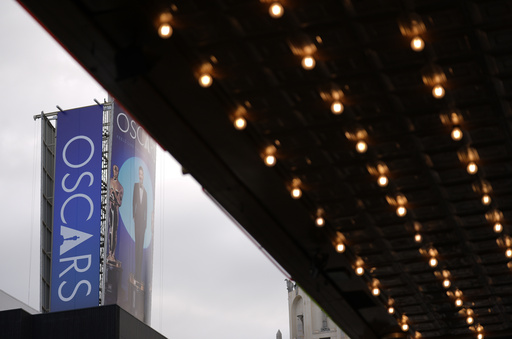NEW YORK (AP) — The Oscars are poised to do something on Sunday that they haven’t done in a very long time: Hand its top award to a blockbuster.
After years of favoring smaller movies like “The Shape of Water” and “Nomadland, ” the clear best-picture favorite “Oppenheimer” — with just shy of $1 billion in tickets sold — is steam rolling toward the kind of big-movie dominance the Academy Awards hasn’t seen in two decades.
You have to go back to Ben Affleck’s “Argo” (2012) to find a best-picture winner that’s grossed more than $100 million domestically. Academy voters’ tastes have instead largely favored smaller independently produced films like “Moonlight,” “Nomadland” and “CODA,” an Apple release with zero reported box office in North America. Last year, the scrappy, distinctly un-Oscar-like indie “Everything Everywhere All at Once” played the role of awards-season underdog until it became an unlikely Academy Awards heavyweight.
But even “Argo,” which walked away with three Oscars after grossing $232.3 million worldwide on a $44.5 million budget, isn’t much of a corollary to “Oppenheimer.” For that, you need to rewind to the 2004 Oscars, where Peter Jackson’s “The Lord of the Rings: Return of the King” — a $1.16 billion smash — took home 11 Oscars. That’s more the kind of wall-to-wall sweep expected Sunday for Christopher Nolan’s J. Robert Oppenheimer biopic.
It’s a reversal all the more striking because the 20 years since “Return of the King” have belonged, overwhelmingly, to the blockbuster. It’s a period that’s included “Avatar,” “Black Panther,” “Top Gun: Maverick,” “The Dark Knight” and the entire run of the Marvel Cinematic Universe. It’s a film culture shift that not everyone in Hollywood — including, most famously, this year’s best director nominee Martin Scorsese — has loved. That’s surely been a factor in Oscar voters embracing less traditional choices in recent years, like the 2020 best-picture champ “Parasite,” the first non-English language winner.
For years, big has been bad at the Academy Awards — a trend the film academy has watched unfold with sporadic panic. After Nolan’s “The Dark Knight” failed to be nominated for best picture in 2009, the academy expanded the best-picture category beyond five films. (It’s now 10.) In 2018, the academy proposed a new “popular film” award, but within weeks that was nixed when Oscar voters rebelled against it.
Such schisms are as old as the Oscars. The first Academy Awards, in 1929, split its top award in two: Outstanding Picture (which went to William Wellman’s dazzling WWI fighter plane action film “Wings”) and Best Unique and Artistic Picture (which went to F. W. Murnau’s silent masterpiece “Sunrise”).
When more widely seen movies are in contention at the Oscars, more people have historically tuned in. The most-watched Academy Awards ever was when “Titanic” ruled the 1998 Oscars, winning 11 trophies. Some 57.3 million viewers watched James Cameron declare “I’m the king of the world!”
This year, there are not one but two billion-dollar blockbusters in the Oscar mix, in “Oppenheimer” and “Barbie,” raising hopes for a telecast that has in recent years hovered closer to a third of the “Titanic”-year viewership. Last year’s ceremony was watched by 18.7 million viewers.
“It makes it 10 times easier,” host Jimmy Kimmel said in a recent interview. “When nobody has seen the movies — and that has happened, including years when I’ve hosted — you have no point of reference to go from.”
It can sometimes be overstated how much having a blockbuster to root for impacts Oscar ratings. The more significant factors tend to be long-term ones, like the decline of linear television and the overall splintering of pop culture. Year-to-year fluctuations are usually less drastic. Nearly as many tuned in to see Clint Eastwood’s “Million Dollar Baby” win best picture in 2005 (42.1 million) as they did the year prior for “Return of the King” (43.5 million).
“Barbenheimer,” though, was a rare phenomenon, and one the Oscars — which lavished a combined 21 nominations on the two films — was eager to embrace. That’s especially because the success of the two films stood in such stark contrast to what the majority in the film industry is currently experiencing.
Both films launched just as actors walked out in a strike that consumed the industry in a protracted battle over streaming, artificial intelligence and the future of the business. Labor strife isn’t over, either; this week, craft workers with IATSE and Teamsters Local 399 began negotiations with studios, talks that much of the industry will be closely watching even as it celebrates at the Oscars.
More than that, “Oppenheimer” stands for a kind of filmmaking that many fear is increasingly obsolete in a Hollywood that’s struggling to find its way forward amid widespread contraction. Streaming revenues have lagged for all but Netflix. Production delays brought on by the strike has led to a downturn in moviegoing in 2024. The sheer, spectacular accomplishment of “Oppenheimer” — a talky three-hour drama that outperformed “Ant-Man” and “Aquaman,” combined — is a bright, shining exception.
“It certainly confirms our faith in what studio filmmaking can be,” Nolan said the morning of Oscar nominations.
The Oscars are always where Hollywood celebrates an idea of itself. Last year, Hollywood told itself with “Everything Everywhere All at Once” that, yes, it could still be boldly original. When “Parasite” triumphed, it was a chest-thump for Hollywood’s expanding internationalism.
This year, Hollywood will hang its hat on an old-fashioned kind of winner — a studio epic — full of awe for what’s possible and dread for what may be to come.
___
Follow AP Film Writer Jake Coyle at: http://twitter.com/jakecoyleAP



